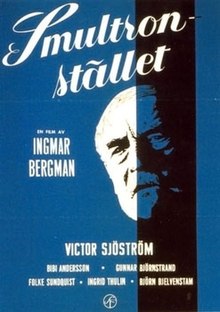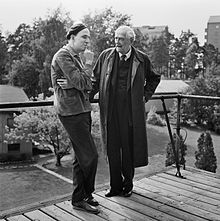| Wild Strawberries | |
|---|---|
 Original film poster | |
| Directed by | Ingmar Bergman |
| Written by | Ingmar Bergman |
| Produced by | Allan Ekelund |
| Starring | Victor Sjöström Bibi Andersson Ingrid Thulin Gunnar Björnstrand |
| Cinematography | Gunnar Fischer |
| Edited by | Oscar Rosander |
| Music by | Erik Nordgren |
| Distributed by | AB Svensk Filmindustri |
Release dates | Sweden: 26 December 1957 United States: 22 June 1959 |
Running time | 91 minutes |
| Country | Template:Film Sweden |
| Languages | Swedish Latin |
Wild Strawberries is a 1957 film written and directed by Ingmar Bergman, about an old man recalling his past. The original Swedish title is Smultronstället, which literally means "the wild strawberry patch", but idiomatically means an underrated gem of a place (often with personal or sentimental value). The cast includes Victor Sjöström in his final screen performance, as well as Bergman regulars Bibi Andersson, Ingrid Thulin and Gunnar Björnstrand. Max von Sydow also appears in a small role. Bergman wrote the screenplay while hospitalized.[1] Because it tackles difficult questions about life, and thought-provoking themes such as self-discovery and humanity's existence, the film is often considered to be one of Bergman's most emotional, optimistic, and best.[2]
Plot
Grouchy, stubborn, and egotistical Professor Isak Borg, a 78 year old widower, is an elderly physician. His medical and scientific specialty was bacteriology. Before specializing he served as general practitioner in rural Sweden. He sets out on a long car ride from Stockholm to Lund to receive the honorary degree Doctor Jubilaris 50 years after graduating from Lund University. Borg is accompanied by his pregnant daughter-in-law Marianne, who does not much like her cool father-in-law and is planning to separate from her husband, Evald, Isak's only son.
During the trip, Isak is forced by nightmares, daydreams, his old age, and his impending death to reevaluate his life. He meets a series of hitchhikers, each of whom set off dreams or reveries into Borg's troubled past. The first group consist of two men and a woman - adored by both men - named Sara, who is a double for Isak's love of his youth (and who is played by the same actress). They remained with him through out his journey. Next they pick up an embittered middle age couple who had just been in an auto accident. The pair exchange such a a terrible vitriol and venom that Marianne stops the car and asks them to leave. They remind Isak of his own life and unhappy marriage. He reminisces about his childhood in the seaside, his sweetheart Sara. He is confronted by his loneliness and aloofness, recognizing these traits both in his ancient mother and in his middle age physician son, and gradually advances towards acceptance of himself, his past, his present, and his soon-to-occur death.[3][4][5]
Borg finally arrives at his destination and picks up his prize, which proves an empty ritual. That night, he bids a loving good-bye to his young friends, to whom the once bitter old man whispers, "remember me". As he goes to his bed in his son's home, he is overcome by a sense of peace and dreams of a family picnic by a lake. Closure and affirmation of life have finally come, and Borg's face radiates joy.
Cast
|
|
Production

Bergman came up with the idea for the film while driving from Stockholm to Dalarna, stopping in Uppsala where he had been born and raised, and driving by outside his grandmother's old house, when he suddenly began to think about how it would be if he could open the door and inside it would be just as it had been during his childhood. "So it struck me - what if you could make a film about this; that you just walk up in a realistic way and open a door, and then you walk into your childhood, and then you open another door and come back to reality, and then you make a turn around a street corner and arrive in some other period of your existence, and everything goes on, lives. That was actually the idea behind Wild Strawberries".[6] Later he would revise the story of the film's genesis. In Images: My Life in Film he comments on his own earlier statement: "That's a lie. The truth is that I am forever living in my childhood."
Bergman wrote the screenplay of Wild Strawberries in Stocholm Karolinska Hospital ( the workplace of Isak Borg ) in the late spring of 1957 after being given the green light to proceed by producer Carl Anders Dymling on the basis of a short synopsis. He was in the hospital for two months, being treated for recurrent gastric problems and general stress. Bergman's doctor at Karolinska was his good friend Sture Helander, who invited him to attend his lectures on psychosomatics. Helander was married to Gunnel Lindblom who was to play Isak's sister Charlotta in the film. Bergman was in a high point of his professional career after a triumphant season a the Malmö City Theatre, where he had been artistic director since 1952 and the success of both Smiles of a Summer Night and the The Seventh Seal. However his private life was in disarray; his third marriage was on the rocks; his affair with Bibi Andersson, which had begun in 1954, was coming to an end; his relationship with his parents was, after an attempted reconciliation with his mother, at desperately low ebb.
The shooting took place between 2 July 1957 and 27 August 1957.[7] The scenes at the summer house were filmed in Saltsjöbaden, a fashionable resort in the Stockholm archipelago. Part of the nightmare sequence was shot with predawn summer light in Gamla stan, the old part of central Stockholm. Most of the movie was made at SF’s studio and on its back lot at Råsunda in northern Stockholm.
Awards and recognition
The film won the Golden Bear for Best Film at the 8th Berlin International Film Festival[8], "Best Film" and "Best Actor" at the Mar del Plata Film Festival and won the Golden Globe for Best Foreign Film in 1960. It was also nominated for an Academy Award for Original Screenplay.
The film is included on the Vatican Best Films List, recommended for its portrayal of a man's "interior journey from pangs of regret and anxiety to a refreshing sense of peace and reconciliation".[9]
The film also influenced Woody Allen’s 1988 drama Another Woman[10]. That film’s main character, Marion Post, is also accused by friends and relatives of being cold and unfeeling, which forces her to reexamine her life. Allen also borrows several tropes from Bergman’s film, such as having Post’s sister-in-law tell her that her brother, Paul, hates her, having a former student tell Post that her class changed her life, and Allen has Post confront the demons of her past via several dream sequences and flashbacks that reveal important information to a viewer, as in Wild Strawberries.
References
- ^ "Wild Strawberries". The Ingmar Bergman Foundation. Retrieved 2007-04-15.
- ^ Murray, Edward (1978). Ten Film Classics: A Re-viewing. F. Ungar Publishing Co. ISBN 9780804426503.
- ^ Malcolm, Derek (10 June 1999). "Ingmar Bergman: Wild Strawberries". The Guardian. London.
- ^ "Wild Strawberries (1957) NYT Critics' Pick". New York Times. June 23, 1959. Retrieved 16 May 2010. [dead link]
- ^ Manvell, Roger. "Plot and review: SMULTRONSTÄLLET (Wild Stawberries)". filmreference.com.
- ^ Bergman om Bergman, Björkman, Maans and Sima, Stockholm 1970, Norstedts Förlag
- ^ Swedish Film Institute on the film (in Swedish) Swedish Film Institute
- ^ "Berlinale: Prize Winners". berlinale.de. Retrieved 2010-01-03.
- ^ U.S. Catholic Bishops - Office of Film and Broadcasting, Vatican Best Films List
- ^ "Another Woman". Chicago Sun-Times.
External links
- Wild Strawberries at IMDb
- Wild Strawberries at the Swedish Film Institute Database
- Wild Strawberries at AllMovie
- Criterion Collection essay by Peter Cowie